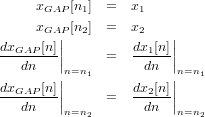

| LTPDA Toolbox™ | contents |   |
Gaps in data can be filled with interpolated data if desired. LTPDA gapfilling joins two AOs
by means of a segment of synthetic data. This segment is calculated from the two input AOs. Two different
methods are possible to fill the gap in the data: linear and spline. The former fills the data
by means of a linear interpolation whereas the latter uses a smoother curve ---see examples below.
b = gapfilling(a1, a2, pl)
where a1 and a2 are the two segments to join.
Linear : The gap is filled using a linear approximation.

Spline : a third order interpolation is used in this case
The parameters a, b, c and d are calculated by solving next system of equations:


1. Missing data between two vectors of random data interpolated with the linear method.
x1 = ao(plist('waveform','noise','nsecs',1e3,'fs',10,'name','noise')); % create an AO of random data
xs = split(x1,plist('chunks',3)); % split in three segments
pl = plist( 'method', 'linear', 'addnoise', 'no'); % linear gapfilling
y = gapfilling(xs(1),xs(3), pl); % fill between 2nd and 3rd segment
iplot(x1,y)

2. Missing data between two data vectors interpolated with the spline method.
x1 = ao(plist('tsfcn','t.^1.8 + 1e6*rand(size(t))','nsecs',5e3,'fs',10,'name','noise')); % create an AO
xs = split(x1,plist('chunks',3)); % split in three segments
pl = plist( 'method', 'spline', 'addnoise', 'no'); % cubic gapfilling
y = gapfilling(xs(1),xs(3), pl); % fill between 2nd and 3rd segment
iplot(x1,y)

 |
Spikes reduction in data | Noise whitening |  |
©LTP Team